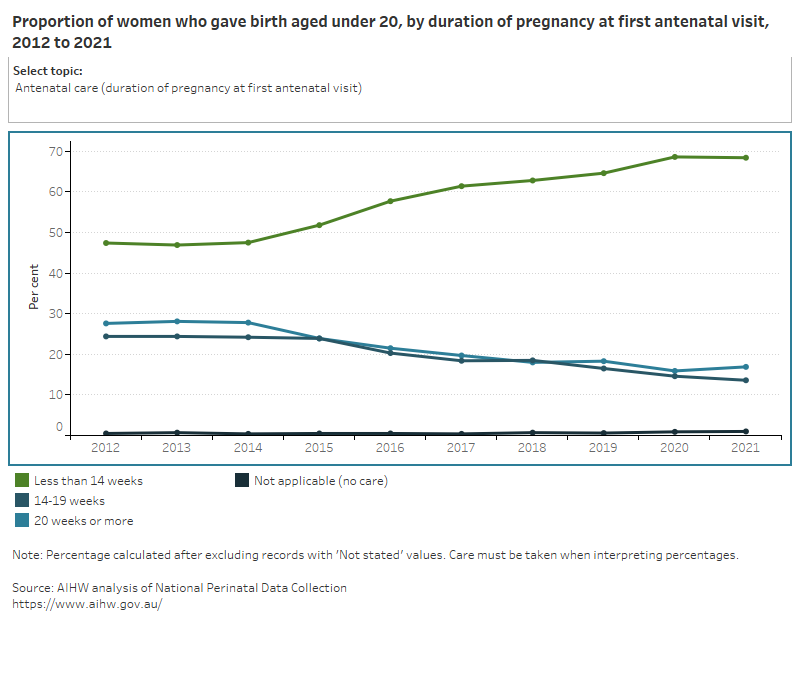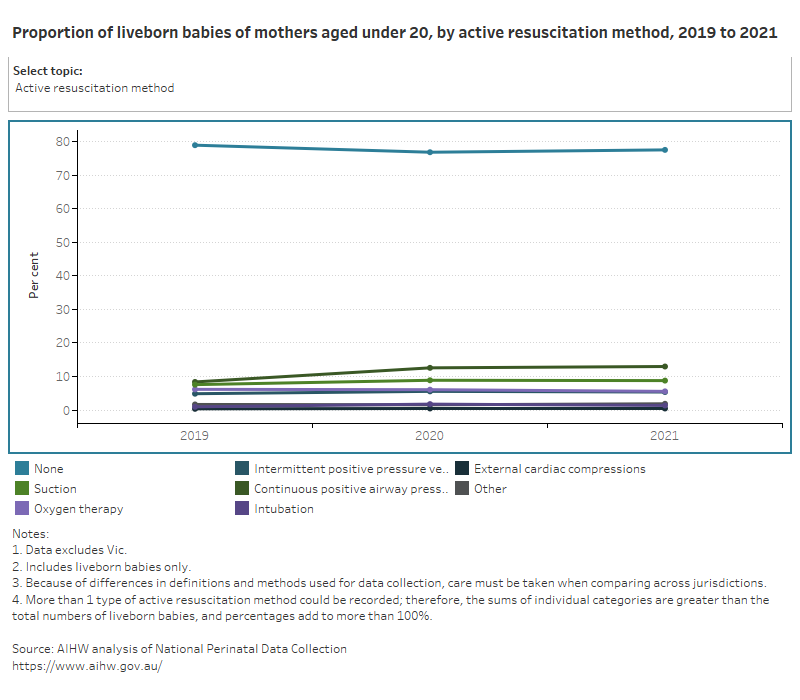Mothers aged under 20 and their babies
This section focuses on teenage mothers (women who gave birth when they were aged under 20) and their babies.
For many young people, becoming a parent can be a positive and maturing experience (AIHW 2020). However, teenage mothers are more likely to experience broader disadvantage, and can have higher rates of behavioural risk factors, such as smoking during pregnancy (AIHW 2018). While most babies born to teenage mothers have positive health outcomes, they are more likely to be pre-term, low birthweight and experience higher morbidity and mortality (AIHW 2018).
Mothers who gave birth aged under 20
In 2021, women who gave birth aged under 20 accounted for 1.5% (4,769) of all mothers. The number of teenage mothers giving birth has more than halved since 2011 (11,016) and the proportion has fallen from 3.7%.
Figure 1 presents data for women who gave birth aged under 20, by selected maternal characteristics over an 11-year period (where available).
Figure 1: Proportion of women who gave birth aged under 20, by selected topic
Line graph of proportion of mothers aged under 20 by selected topics between 2012 and 2021.

Many teenage mothers access antenatal care in the first trimester (68%) and have more than 5 antenatal visits (91%). In particular, the rate of antenatal visits in the first trimester has been rising over time.
Teenage mothers have high smoking rates, with 1 in 3 (33%) smoking during pregnancy in 2021, however this rate has fallen over time (from 36% in 2011).
Although teenage mothers are more likely to have spontaneous onset of labour, this rate has fallen over time (from 68% in 2011 to 53% in 2021) with a corresponding increase in induced labour onset (from 27% in 2011 to 40% in 2021). Because spontaneous and induced labour are most commonly associated with vaginal birth, this means that the rate of vaginal births and caesarean sections has remained largely stable.
It is important to note that teenage mothers experience significant differences in relation to maternal characteristics, health behaviours and outcomes – and perinatal outcomes – when compared to the overall population of Australian mothers and babies. These differences can be explored when viewing Maternal age at the chapter or topic level throughout this report.
Babies born to mothers aged under 20
In 2021, babies born to mothers aged under 207 accounted for 1.5% (4,754) of all births.
Figure 2 presents data for babies born to women who gave birth aged under 20, by selected baby characteristics over an 11-year period (where available).
Figure 2: Proportion of liveborn babies of mothers aged under 20, but selected topic
Line graph of babies of mothers aged under 20 by selected topics between 2019 and 2021.

In 2021, most babies born to mothers aged under 20 were born at term and had a normal birthweight (88% and 89%, respectively). The majority of babies had a hospital stay of 3 days or less (82%).
Around 1 in 4 babies born to mothers aged under 20 required active resuscitation or admission to SCN/NICU (23% and 24%, respectively).
References
AIHW (Australian Institute of Health and Welfare) (2018) Teenage mothers in Australia 2015, AIHW, Australian Government, accessed 15 June 2022.
AIHW (Australian Institute of Health and Welfare) (2020) Australia’s children, AIHW, Australian Government, accessed 20 June 2022.


